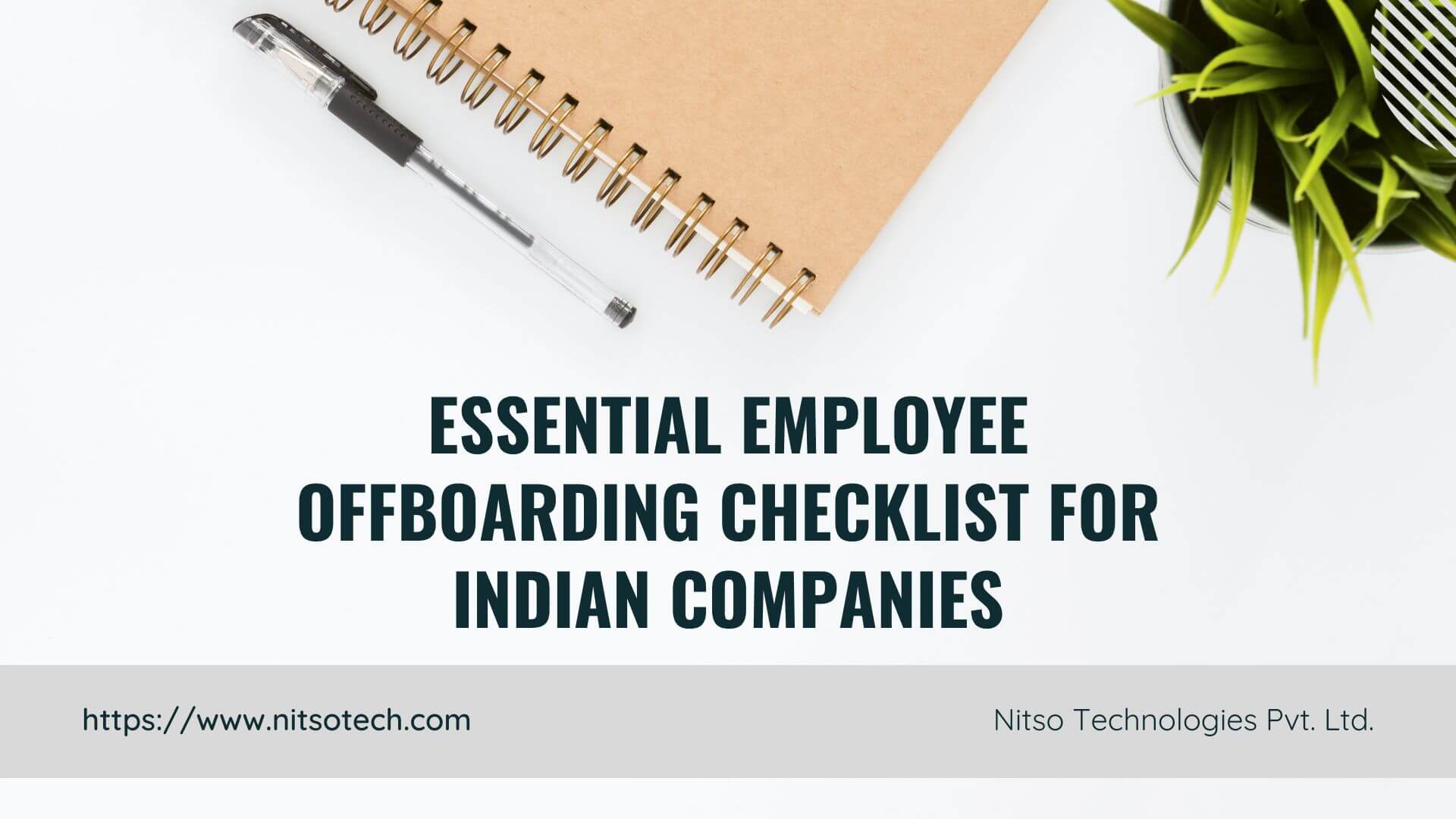Having a solid employee offboarding checklist is crucial for companies in India. When an employee leaves your organization, whether voluntarily or involuntarily, you need to have a structured process in place to transition them out smoothly. The offboarding period is the last experience an employee will have with your company. A positive and organized offboarding leaves a good impression and paves the way for future references or even rehiring.
On the other hand, a disorganized or abrupt ending can cause legal issues, data breaches, or damage to your employer brand if the departing employee shares negative feedback. That’s why having a thoughtful and comprehensive employee offboarding checklist is so important for Indian companies today.
This article will examine the key elements to include in your offboarding process and provide tips for making the transition positive for all involved. Proper offboarding benefits your organization, the departing employee, and the remaining staff. By following an organized employee offboarding checklist, you can protect company assets, maintain relationships, and build your employer brand.
On This Page
Why Offboarding Matters?
The offboarding process is often overlooked or handled hastily, especially when an employee resigns voluntarily. However, having a structured employee offboarding is crucial for several reasons:
- It allows the company to protect confidential information and intellectual property. Without proper offboarding, employees may walk away with sensitive company data, accounts, networks, trade secrets, or client details.
- It maintains positive relationships between the employer and the departing employee. Respectful exits leave a good impression and help safeguard your brand as an employer.
- It smoothens the transition for remaining employees. They need closure and a plan to handle the departing employee’s responsibilities.
- It ensures legal compliance. In India, labor laws mandate certain steps for employee exits like final settlements, documentation, and relieving letters.
- It gives visibility into process gaps. Feedback and exit interviews during offboarding provide insights to enhance HR policies.
The employee offboarding serves multiple stakeholders – the employee, employer, and remaining team members. That’s why having a robust and thoughtful checklist is essential. Don’t wait until an exit notice lands on your desk. Be proactive and prepare your offboarding process beforehand.
Key Elements of an Offboarding Checklist in India
When creating an employee offboarding checklist for India, there are several important elements to include:
Step 1: Review and return of company property
- Create a detailed list of all company assets assigned to the employee such as laptops, mobile phones, ID cards, uniforms, protective equipment, credit cards, keys, documents etc.
- Schedule a meeting with the employee to collect and inventory all listed items. HR and the concerned department head should be present.
- Cross-check to ensure nothing is missing. Items not handed back should be accounted for.
- Have the employee sign the asset list acknowledging the return of all company property.
Step 2: Have an exit interview
- HR should schedule a structured exit interview on the employee’s last day.
- Discuss the reasons for departure and get constructive feedback on their work experience.
- Maintain a polite and professional tone throughout. Avoid getting defensive.
- Capture feedback on issues related to work culture, learning opportunities, facilities, policies etc. that the company can improve on.
- Thank the employee for their contributions and wish them the best for the future.
Step 3: Settle final payments and get no dues certificate
- Calculate and settle all remaining dues per Indian labour laws – salary, leaves, bonus, gratuity etc.
- Obtain No Dues certification from relevant departments like IT, Admin, Finance, HR etc.
- Provide relieving letters, experience letters and other documents sought by the employee.
- Get the Full and final settlement documents signed off.
Step 4: Cancel access to company systems and facilities
- Terminate access to email, Slack, project management tools, VPN etc. on the last working day.
- Revoke access badges and disable biometric/card entries.
- Remove from all internal systems and directories.
- Inform third-party vendors to block access to any portals being used.
- Change passwords and OTP procedures for security.
Step 5: Transition the departing employee’s work
- Identify pending work and critical handovers for the departing employee.
- Assign tasks to other team members and train them on any specialized processes.
- Introduce the new team member taking over the existing employee’s responsibilities.
- Schedule enough transition time for handovers before the last day.
Step 6: Communicate the departure to the relevant staff
- Inform key internal stakeholders like the employee’s team, cross-functional partners, senior management etc.
- Announce organizational changes and succession plans to minimize disruption.
- For customer-facing roles, inform key external stakeholders and clients about the transition.
Step 7: Conduct security debriefing
- Conduct a security debriefing as per company policy for roles dealing with sensitive data.
- Remind employees of confidentiality agreements and proprietary information access.
- Reiterate security and data privacy protocols to be followed post-exit.
Step 8: Offer assistance with references or certificates
- Provide experience letters and other documents related to tenure and work done.
- Assure the employee you will provide a positive reference for future opportunities.
Step 9: Get feedback from the departing employee
- Schedule an exit interview with the employee on or before their last working day.
- Come prepared with a list of open-ended questions that allow the employee to elaborate on their experience and decision to leave.
- Maintain a polite and respectful discussion. Do not get defensive about any criticism.
- After the employee answers from their perspective, summarize the key points you have noted down.
- Thank the employee for their insights and honesty. The feedback will help improve the workplace.
- Analyze the feedback after the exit interview to identify actionable points for improvement.
Getting unfiltered and constructive criticism from departing employees through offboarding feedback is invaluable. It provides unique insights that existing staff may not feel comfortable sharing. Make the exit interview count.
Additional Considerations
When creating an employee offboarding checklist for India, you need to keep some additional considerations in mind:
- Legal compliance – Make sure your offboarding process complies with all applicable Indian labour laws related to final dues, documentation, notice period, severance, etc. Non-compliance can lead to employee disputes.
- Cultural sensitivity – Exits can be emotional events in India. Ensure any farewells, handovers, or announcements are done in a culturally appropriate manner. Respect the employee’s preferences.
- Data security – Reiterate and enforce data security policies during offboarding. Departing employees may try to take client contacts, upcoming tender details etc. which can hurt the company.
- Protecting reputation – Counsel the employee to not speak negatively about your company on social media or professional platforms after they leave. Offboarding with empathy prevents reputational risks.
- Future networking – Rather than a hostile break, aim for a respectful offboarding that keeps future professional networking and re-hiring potential open.
- Feedback loop – Learn from exit interviews to fix issues raised by departing employees related to work culture, policies, facilities, etc.
Keeping these additional factors in mind while using your employee offboarding checklist ensures a thoughtful, compliant and culturally appropriate exit. The process can then benefit all stakeholders.
Benefits of a Thoughtful Offboarding Process
Implementing a structured employee offboarding checklist has several advantages for organizations:
- Smoother transitions – A methodical offboarding process ensures minimal disruption when an employee exits. Work is handed over seamlessly and operations continue uninterrupted.
- Data security – Following offboarding protocols like access termination, exit interviews, and system audits helps safeguard company data and IP.
- Positive employer brand – Respectful offboarding reflects well on the organization’s culture and values. Departing employees become brand ambassadors.
- Future rehiring potential – Keeping the exit process friendly and constructive maintains your professional network and alumni talent pipeline. Past employees may boomerang back.
- Compliance – A systematic checklist ensures all regulatory and legal obligations related to employee exits are fulfilled. This prevents future liabilities.
- Valuable feedback – Offboarding interviews provide insights into improving policies and work culture based on feedback from departing staff.
- Closure for the team – A structured offboarding process gives remaining employees a sense of closure and clarity when a colleague leaves.
Key Takeaways
An employee offboarding checklist is an important investment for companies in India looking to:
- Protect confidential data and intellectual property of the organization
- Uphold compliance with Indian labour laws and statutory regulations
- Maintain positive relationships with departing employees
- Build a strong employer brand that attracts future talent
- Make employee transitions smooth and minimize disruption
- Capture feedback to strengthen HR policies and work culture
- Sustain professional networks and rehiring potential
By having a structured offboarding process outlined in an employee offboarding checklist, organizations can transform exits into positive experiences. Being organized, respectful, and thorough during offboarding allows both parties to exit on good terms.
Some final tips
- Prepare your offboarding checklist proactively – don’t wait for exits
- Customize the checklist to reflect Indian statutory requirements
- Automate aspects like system access termination for efficiency
- Use offboarding as an opportunity to take feedback and improve
With these best practices in mind, companies can leverage their employee offboarding checklist to build their brand, maintain compliance, and reduce offboarding risks. While this article has focused on the essential steps and best practices of offboarding, the integration of HR software stands as a promising frontier for further enhancing this critical procedure.
HR software has the potential to transform the offboarding checklist from a static document into a dynamic, interactive, and automated process. Such technology can streamline the administrative burden, ensure accuracy and consistency, and provide a more seamless experience for both the HR team and the departing employee.
FAQs Employee Offboarding Checklist
Why is offboarding important for companies in India?
Proper offboarding protects company data, maintains compliance with Indian labour laws, secures company assets, and leaves a positive employer brand impression.
When should you create an offboarding checklist?
The offboarding checklist should be created proactively before any employee resignations. Don’t wait until an exit notice to plan it.
What are some key elements of an offboarding checklist in India?
Key elements are final payments, documentation, asset returns, access termination, handovers, communication, and exit interviews.
How does a good offboarding process help companies?
It ensures smooth work transitions, provides feedback for improvement, sustains professional networks, and upholds a positive brand image.
What legal obligations should Indian companies follow during offboarding?
Companies must furnish documents like relieving letters, follow labour laws for final dues, and get necessary certificates signed.
How can offboarding checklists prevent data theft in India?
They mandate blocking system access, remind about IP rights, take back company devices, and conduct security debriefs.
Why should offboarding aim to part on good terms?
Exiting respectfully maintains future rehiring potential and gets positive referral for employer brand.
What feedback should employers collect during exit interviews?
Exit interviews should cover feedback on work culture, policies, tools, learning opportunities etc. to improve.








0 Comments